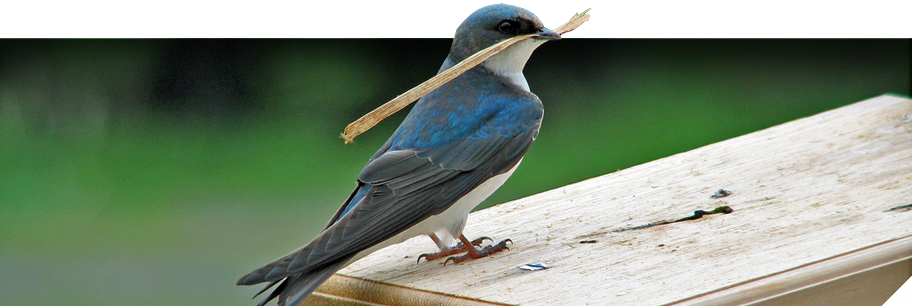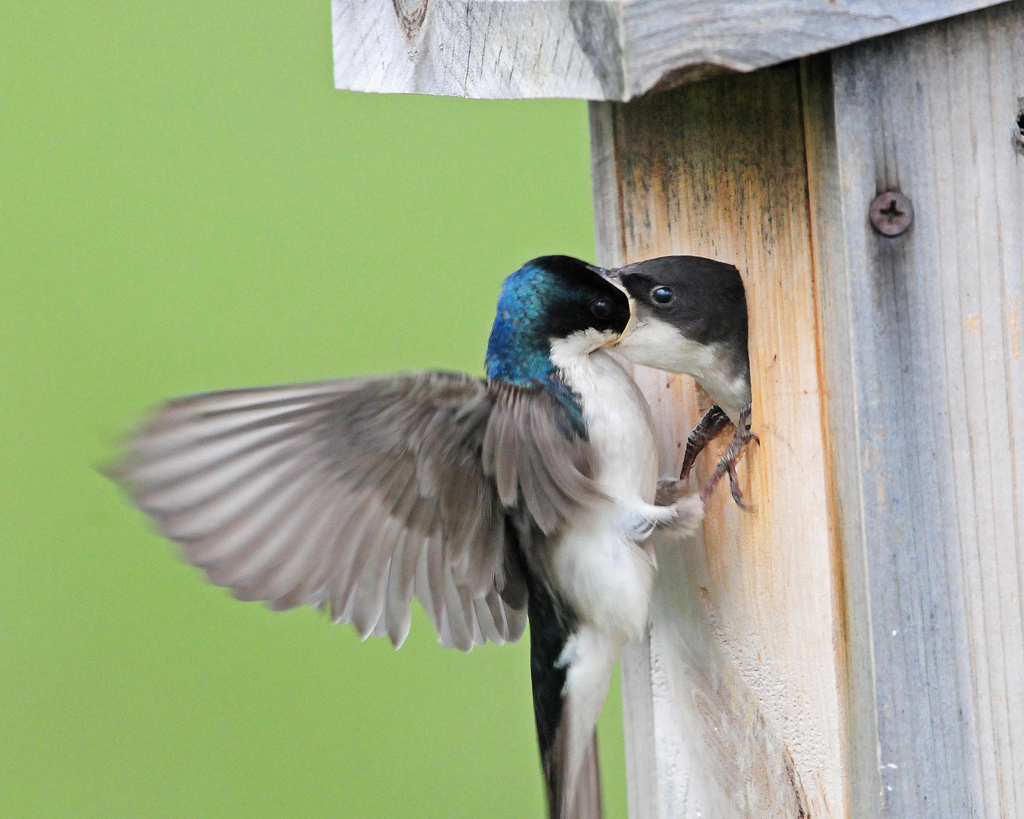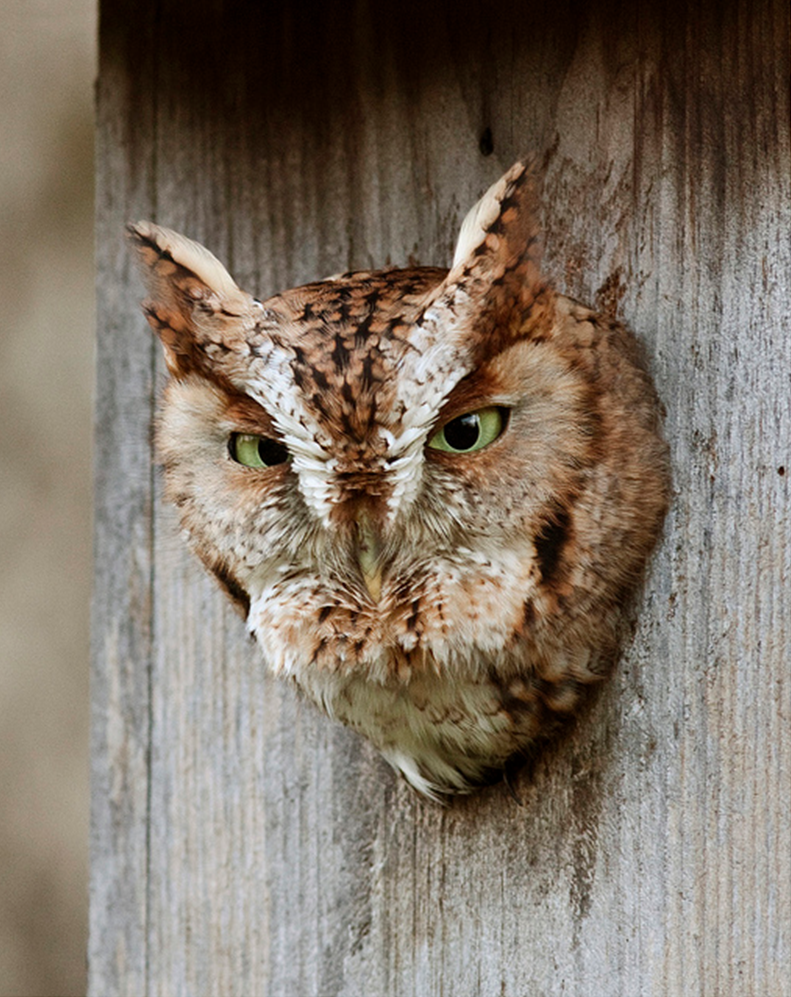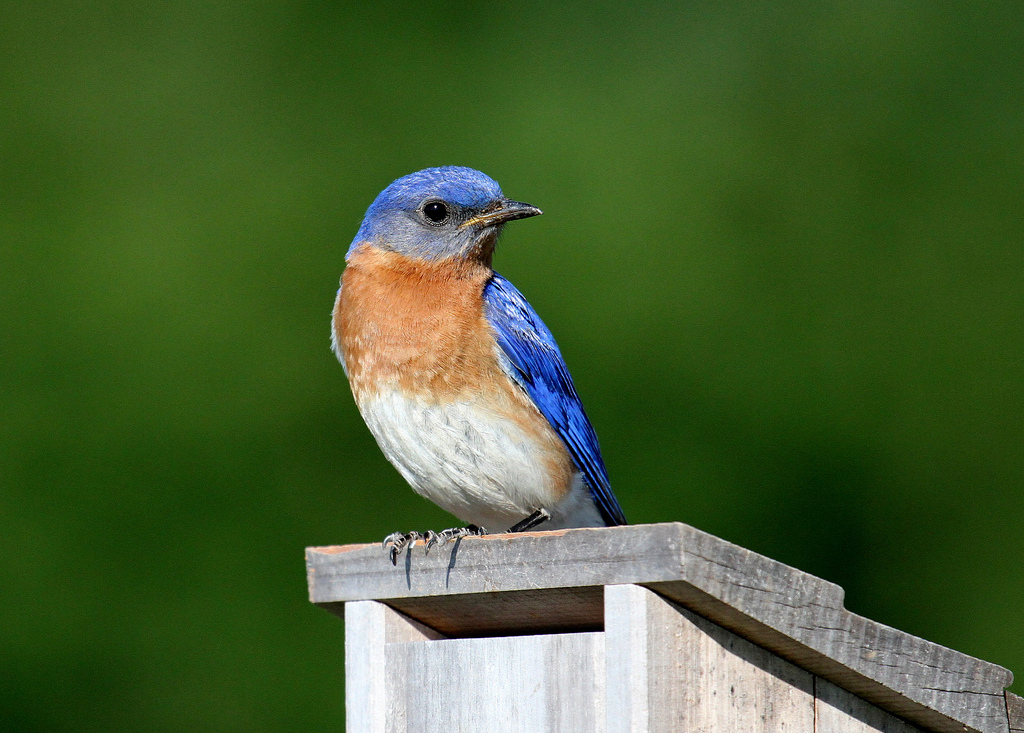What Is the Best Place to Put Bluebird House
 Photo © Robert J. Bakery
Photo © Robert J. Bakery Nest Box Placement
Need help placing your boxes? Yous've come up to the right place!

Tree Swallow Feeds Nestling
When to Place Boxes
Brand sure that your boxes are installed well earlier the breeding flavor begins. Don't be discouraged if birds don't brainstorm nesting in them immediately; sometimes it takes fourth dimension for the birds to find them.
- In the south, place your nest boxes past February.
- In northern regions, identify your nest boxes past mid to late March.

Eastern Screech-owl, Red Morph
Where to place nest boxes
Considering different species of birds prefer unlike kinds of nesting habitat, the vegetation surrounding your box will play a role in determining which species volition nest in it. Remember: right box, right place. For example, nest boxes for bluebirds should be placed in open habitat. Refer to the habitat requirements page for specific information.
If you are looking to attract a variety of species to your nest boxes and have ample room, you might consider pairing your boxes. This involves placing boxes in pairs on poles 15 to 25 anxiety apart. Or, you lot can put two boxes back to back on a single pole. Birds such every bit Tree Swallows and bluebirds will nest closely to i another, although they will drive away others of their own species. Pairing boxes has the advantage of allowing more birds of both species to coexist peacefully within the same habitat.
A word of caution: Golf courses, cultivated fields, gardens, and yards are potentially good habitats for nest boxes, only avert areas where pesticides and herbicides are used. These are not only harmful to birds, they subtract and sometimes eliminate the insect populations that are the primary food source for many cavity-nesting species.

Male person Eastern Bluebird
How to identify your nest box
Whichever method y'all choose to install your boxes, be certain that they are secure enough to withstand loftier winds and severe weather condition. The all-time way to put up pocket-sized nest boxes is on free-standing metal poles or PVC pipes. These pipes or poles offer several advantages:
- Nest boxes can be mounted higher than when mounted on a debate post.
- Some predators discover poles difficult to climb.
- Poles tin be easily equipped with predator guards.
- Get construction plans for building predator guards.
Requirements for Your Favorite Cavity-nesting Birds
| Species | Nesting Habitat | Box Height | Hole Size | Minimum Spacing |
|---|---|---|---|---|
| American Kestrel | Pastures, fields, meadows, or orchards with mowed or grazed vegetation; identify boxes on lone copse in fields, on trees along edges of woodlots, and on farm buildings. Facing s or east | ten-30 feet | three" bore | 1/two mile |
| Ash-throated Flycatcher | Chaparral, mesquite thickets, oak scrub, dry out plains spotted with copse or cacti, deserts, and open deciduous and riparian woodlands | 3-twenty feet | one iii/iv" round | 200 feet |
| Barn Owl | Prefers open up areas like fields, deserts and marshes which are in close proximity to hollow trees, cliffs, riverbanks, or man-fabricated structures, including barns, bridges and other accessible sites, and which back up healthy rodent populations | 8-25 feet | 3 three/iv" ten iv 1/2" elliptical | 100 feet |
| Black-capped Chickadee | Forests, woodlots, and yards with mature hardwood trees, forest edges, meadows; area should receive forty-60% sunlight, hole should face away from prevailing wind; 1" wood shavings can be placed in box | 5-15 feet | ane 1/viii" round | 650 anxiety |
| Chocolate-brown-headed Nuthatch | Open stands of pine-hardwood forests, clearings scattered with expressionless trees, wood edges, burned areas, cypress swamps | 5-10 feet | 1" circular | one box per half dozen acres |
| Carolina Chickadee | Forests, woodlots, and yards with mature hardwood trees, forest edges, meadows; surface area should receive xl-60% sunlight, pigsty should face away from prevailing wind. Unlike other chickadees, Carolina Chickadee does not practice much excavating, so forest chips are not necessary. | 4-15 feet | 1 1/8" round | 30 feet |
| Carolina Wren | Forests with thick underbrush, wood edges, woodland clearings, open up forests, shrub lands, suburban gardens, parks, backyards; near trees or alpine shrubs | iii-6 feet | i 1/2" round, or 2 1/ii" ten 5" slot | 330 feet |
| Chestnut-backed Chickadee | Coniferous forests, mixed deciduous-coniferous forests, forest edges, woodlands, thickets, burned areas, frequently near streams; hole should confront abroad from prevailing wind; 1" wood shavings can be placed in box | 5-15 feet | 1 1/8" round | 160 feet |
| Common Goldeneye | Breeding habitat is limited to aquatic areas with expressionless trees, in boreal, deciduous, aspen and montane forest; favor calm, large, clear lakes without much vegetation or fish. Please several inches of wood shavings in the box in early bound. | 6-30 feet | 3 ane/4" high x 4 1/iv" wide | 2/3 mile |
| Eastern Bluebird | Open field or lawn; orchards; open, rural country with scattered trees and low or sparse ground cover; entrance pigsty should face open field, preferring east, north, south, and so westward-facing directions | 3-6 feet | 1 one/ii" diameter (round), or two 1/iv" loftier x i 3/8" broad (oval) | 300 feet |
| Eastern Screech-Owl | Forests, parks, woodland clearings, wood edges, wooded stream edges, under a tree limb. Add 2"-iii" of wood shavings | 10-30 feet | 3" round | 100 feet |
| European Starling | Habitat generalists, nesting in areas ranging from rural and agricultural to suburban and urban areas, but they avoid heavily wooded, mountainous, and barren regions | providing nest boxes is discouraged for this species in the U.S. | can squeeze through holes with 1 9/sixteen" bore | v feet |
| Great Crested Flycatcher | Deciduous or mixed deciduous-coniferous forests, forest edges, woodlots, orchards, parks, on post or tree at forest border | 3-20 feet | 1 3/4" round | 1 box per vi acres |
| Hooded Merganser | Quiet, shallow, clear water pools surrounded by or virtually the edge of deciduous woods: small forest pools, ponds, swamps; add iii" of woods shavings; add ladder under inside of entrance hole for young to climb out | vi-25 feet | 3" loftier by 4" wide horizontal oval | 100 anxiety |
| House Sparrow | Agronomical, suburban, and urban areas; tend to avert woodlands, forests, grasslands, and deserts | providing nest boxes is discouraged for this species in the U.South. | can fit through holes with one ane/4" bore | variable |
| House Wren | Diverseness of habitats, farmland, openings, open forests, woods edges, shrub lands, suburban gardens, parks, backyards; virtually trees or tall shrubs | 5-ten feet | 1" round | 100 anxiety |
| Mount Bluebird | Open field or lawn; orchards; open up, rural country with scattered trees and low or sparse ground comprehend; will likewise use deciduous and coniferous forest edges; entrance hole should face open field, preferring east, north, south, and so west-facing directions | 4-vi feet | 1 9/16" diameter | 300 feet |
| Mount Chickadee | Coniferous forests, forest edges, woodland clearings; hole should face away from prevailing current of air; 1" wood shavings can be placed in box | 5-15 feet | one ane/8" round | 1 box per 10 acres |
| Northern Flicker | Pastures, groves, woodlots, orchards, fields, meadows, woodland clearings, forest edges, urban parks, on pole or tree at forest edge or along fence rows bordering crop fields; south or e facing; box should be completely filled with woods fries or shavings | 6-12 feet | ii 1/ii" round | 330 anxiety |
| Prothonotary Warbler | Lowland hardwood forests subject area to flooding, stagnant water, swamps, ponds, marshes, streams, flooded river valleys, wet bottomlands; box should exist over or near water | four-12 feet | 1 1/4" round | 235 feet |
| Purple Martin | Broad open up areas (meadows, fields, farmland, swamps, ponds, lakes, rivers) with unobstructed space for foraging on flying insects; there should be no trees or buildings within 40 anxiety of the martin pole in any direction; houses should be painted white | ten-15 feet | 2 i/viii" circular or 3" wide x i iii/16" high crescent | ten feet |
| Ruddy-breasted Nuthatch | Mixed coniferous-deciduous forests, shrub lands, swamps, farmlands, suburban parks; hole should face away from prevailing wind; one" wood shavings can exist placed in box | 5-15 anxiety | ane 1/4" round | 150 feet |
| Tree Swallow | Open up fields nearly water, expansive open up areas, marshes, meadows, wooded swamps; on a post in open areas almost tree or fence, eastward facing | 5-6 feet | i 3/8" circular | 35 feet |
| Tufted Titmouse | Deciduous forest, thick timber stands, woodland clearings, forest edges, woodlots, riparian and mesquite habitats; hole should face abroad from prevailing wind | 5-15 feet | 1 1/4" round | 580 feet |
| Violet-green Swallow | Open up or broken deciduous or mixed deciduous-coniferous forests, wooded canyons, edges of dense forest | nine-15 feet | 1 3/eight" round | 30 feet |
| Western Bluebird | open up field or lawn; orchards; open, rural country with scattered trees and low or sparse footing cover; volition also use deciduous and coniferous woods edges; entrance pigsty should face open up field, preferring due east, n, south, and and so west-facing directions | 4-6 feet | ane 1/2" bore | 215 feet |
| Western Screech-Owl | Lower elevations, forests, parks, woodland clearings, forest edges, deserts, wooded stream edges, under a tree limb, south or eastward facing. Add together 2"-3" of wood shavings | ten-30 anxiety | 3" round | 1,000 feet |
| White-breasted Nuthatch | Deciduous woodlands, mature forests, woodlots, well-nigh open areas, wood edges, orchards, often about h2o; hole should face away from prevailing current of air; i" wood shavings tin can be placed in box | 5-20 feet | 1 1/four" round | ane,040 anxiety |
| Wood Duck | Forested wetlands or well-nigh marshes, swamps, and beaver ponds; boxes can be installed on posts or poles in water, at least 3 feet to a higher place the high water mark, facing due south or west. If installing on land, choose a site inside 100 anxiety of h2o with no branches near the entrance hole and with a predator baby-sit. Place 4 inches of forest shaving in box floor. Box should have fledgling ladder inside archway hole to enable immature to climb out. | 6-xxx feet | iv" wide, three" high | 600 feet |
Source: https://nestwatch.org/learn/all-about-birdhouses/nest-box-placement/
0 Response to "What Is the Best Place to Put Bluebird House"
Post a Comment